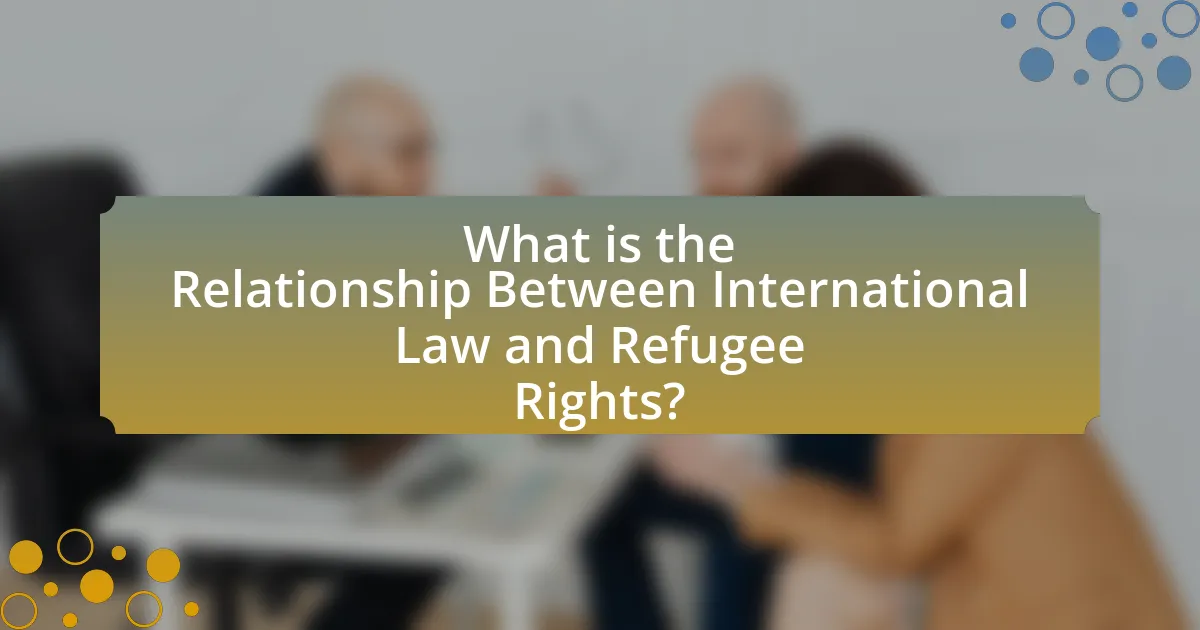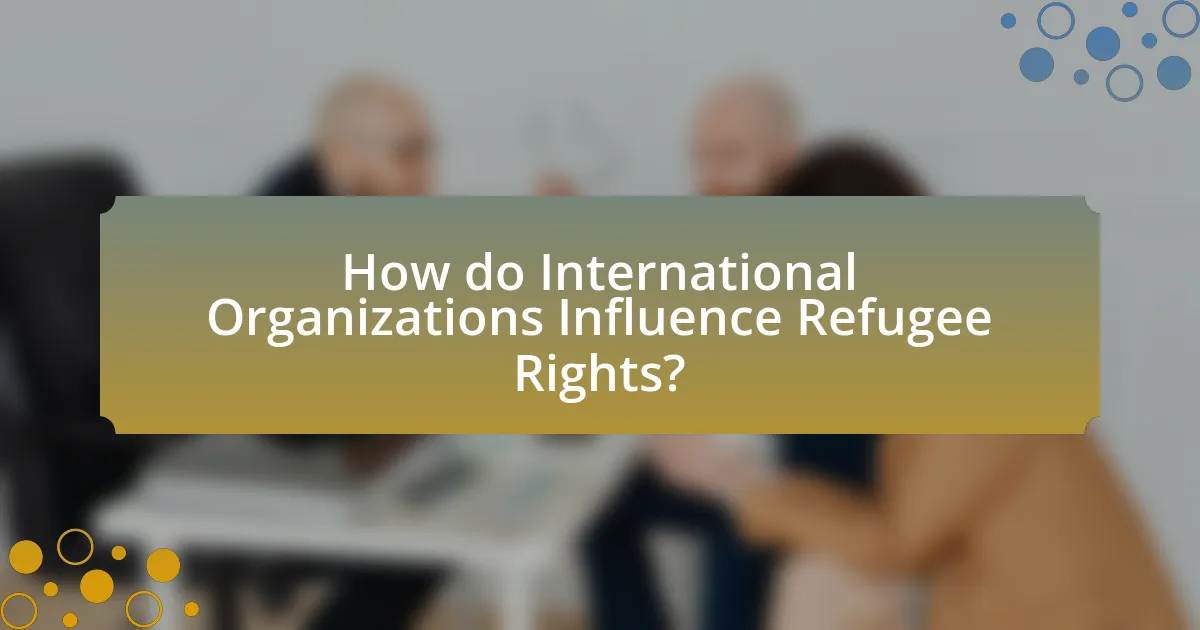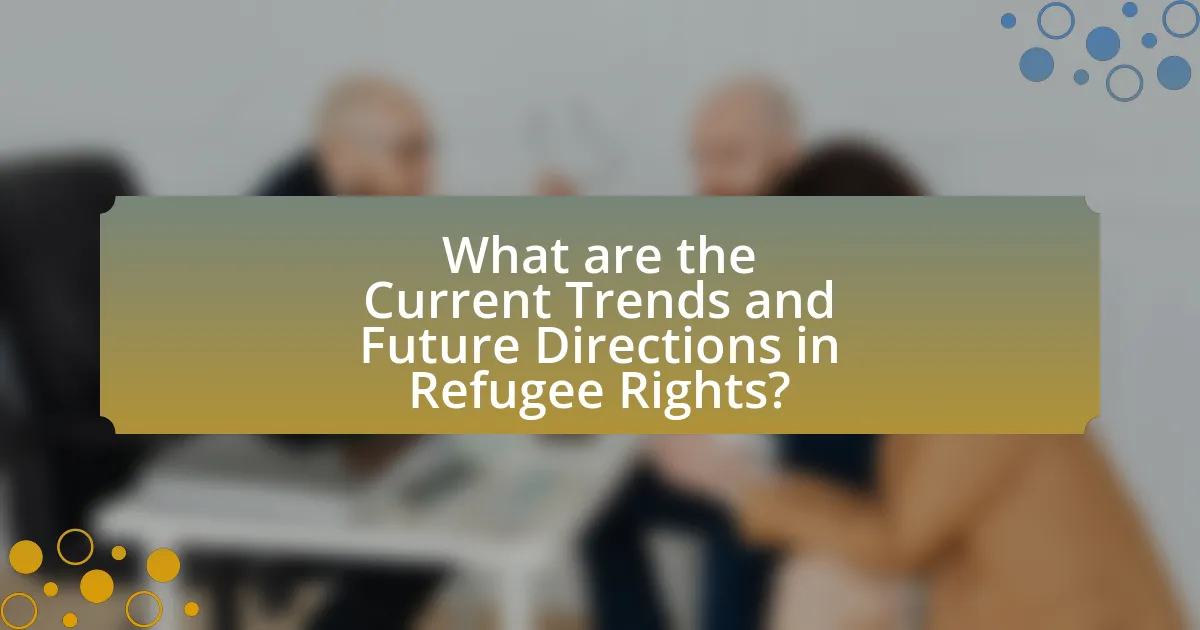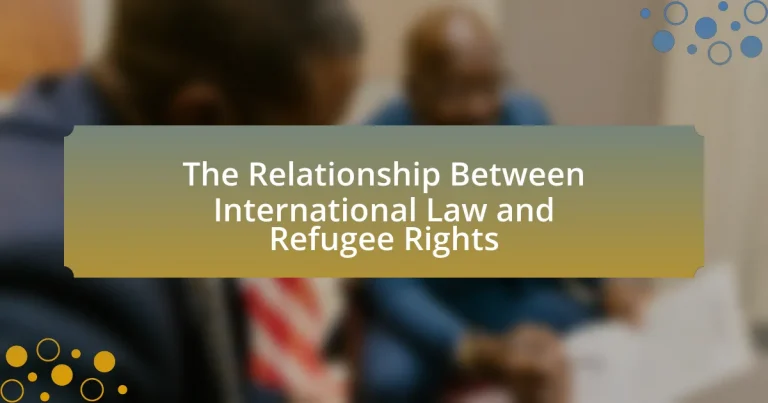The article examines the relationship between international law and refugee rights, highlighting the foundational role of treaties such as the 1951 Refugee Convention and its 1967 Protocol. It outlines how these legal instruments define refugee rights, including the right to seek asylum and the principle of non-refoulement, which protects refugees from being returned to dangerous situations. The article also discusses the influence of international and regional organizations, the challenges in enforcing refugee rights, and the impact of emerging global issues like climate change on refugee movements. Additionally, it explores best practices for enhancing compliance with international refugee law and the critical role of civil society in advocating for refugee rights.

What is the Relationship Between International Law and Refugee Rights?
International law establishes the framework for refugee rights, primarily through treaties such as the 1951 Refugee Convention and its 1967 Protocol, which define who qualifies as a refugee and outline the rights of individuals seeking asylum. These legal instruments obligate states to protect refugees from return to places where they face serious threats to their life or freedom, ensuring their right to seek asylum and receive protection. The relationship is further reinforced by customary international law and human rights treaties, which collectively emphasize the obligation of states to uphold the dignity and rights of refugees, thereby creating a comprehensive legal environment that safeguards their well-being and integration into host societies.
How does international law define refugee rights?
International law defines refugee rights primarily through the 1951 Refugee Convention and its 1967 Protocol, which establish the legal framework for the protection of refugees. These instruments affirm that refugees have the right to seek asylum, the right not to be returned to a country where they face serious threats to their life or freedom (non-refoulement), and the right to access basic services such as education and healthcare. The Convention outlines specific rights, including the right to work, the right to freedom of movement, and the right to legal assistance, thereby ensuring that refugees are treated with dignity and respect. These rights are further reinforced by customary international law and various human rights treaties, which collectively emphasize the obligation of states to protect individuals fleeing persecution.
What are the key international treaties related to refugee rights?
The key international treaties related to refugee rights are the 1951 Refugee Convention and its 1967 Protocol. The 1951 Refugee Convention defines who qualifies as a refugee and outlines the rights of individuals granted asylum, as well as the responsibilities of nations to protect them. The 1967 Protocol expands the scope of the Convention by removing geographical and temporal restrictions, thereby ensuring that refugee protections apply universally. These treaties are foundational in establishing the legal framework for refugee rights and have been ratified by numerous countries, reinforcing their significance in international law.
How do these treaties influence national laws on refugees?
International treaties significantly influence national laws on refugees by establishing binding legal standards that countries must adhere to. For instance, the 1951 Refugee Convention and its 1967 Protocol outline the rights of refugees and the obligations of states to protect them, compelling nations to incorporate these principles into their domestic legislation. Countries that ratify these treaties are required to ensure that their national laws align with the definitions and protections set forth in the treaties, which often leads to the creation or amendment of laws regarding asylum procedures, refugee status determination, and the rights of refugees within their borders. This alignment is crucial for maintaining international standards and ensuring that refugees receive adequate protection and support as mandated by international law.
Why is the relationship between international law and refugee rights important?
The relationship between international law and refugee rights is important because it establishes legal frameworks that protect individuals fleeing persecution and conflict. International law, particularly through instruments like the 1951 Refugee Convention, defines who qualifies as a refugee and outlines the rights of refugees, including the right to seek asylum and the principle of non-refoulement, which prohibits returning refugees to places where they face serious threats to their life or freedom. This legal protection is crucial in ensuring that refugees receive safety and support, as it obligates states to uphold these rights and provides mechanisms for accountability.
What impact does this relationship have on global refugee policies?
The relationship between international law and refugee rights significantly shapes global refugee policies by establishing legal frameworks that govern the treatment and protection of refugees. International treaties, such as the 1951 Refugee Convention and its 1967 Protocol, obligate signatory states to uphold the rights of refugees, influencing national policies to align with these international standards. For instance, countries that adhere to these agreements are required to provide asylum and ensure non-refoulement, which prohibits returning refugees to places where they face threats to their life or freedom. This legal obligation compels nations to develop comprehensive asylum systems and integrate refugee rights into their domestic laws, thereby impacting how refugees are treated globally.
How does international law protect refugees in conflict situations?
International law protects refugees in conflict situations primarily through the 1951 Refugee Convention and its 1967 Protocol, which establish the legal framework for refugee rights and the obligations of states. These instruments define a refugee as someone who has a well-founded fear of persecution due to race, religion, nationality, membership in a particular social group, or political opinion, and they obligate states to refrain from returning refugees to places where their lives or freedoms would be threatened, a principle known as non-refoulement. Additionally, international humanitarian law, particularly the Geneva Conventions, provides protections for individuals in armed conflict, including refugees, ensuring their rights to safety, dignity, and access to basic needs. These legal frameworks are reinforced by various UN resolutions and guidelines that emphasize the need for states to protect refugees and provide them with asylum and support during conflicts.
What challenges exist in the enforcement of refugee rights under international law?
Challenges in the enforcement of refugee rights under international law include lack of political will, inconsistent application of laws, and limited resources for implementation. Many states prioritize national security over humanitarian obligations, leading to selective adherence to international treaties like the 1951 Refugee Convention. Additionally, the absence of a centralized enforcement mechanism means that compliance relies heavily on individual states, which may interpret their obligations differently. For instance, a report by the United Nations High Commissioner for Refugees (UNHCR) highlights that only 30% of countries provide adequate legal frameworks for refugee protection, indicating significant gaps in enforcement.
What role do states play in upholding these rights?
States play a crucial role in upholding refugee rights by enacting and enforcing laws that align with international legal standards. They are responsible for implementing treaties such as the 1951 Refugee Convention, which obligates them to protect individuals fleeing persecution. States must also establish legal frameworks that provide asylum procedures, ensuring that refugees have access to fair hearings and protection from refoulement, the practice of returning refugees to countries where they face threats to their safety. Additionally, states are tasked with providing basic rights and services to refugees, including access to education, healthcare, and employment, as outlined in various international human rights instruments.
How do political factors affect the implementation of international refugee law?
Political factors significantly influence the implementation of international refugee law by shaping national policies and priorities regarding asylum seekers. Governments may prioritize political stability, national security, or public opinion over their legal obligations, leading to inconsistent application of refugee protections. For instance, during the Syrian refugee crisis, countries like Hungary and Poland adopted restrictive measures, citing national security concerns, which contradicted their commitments under the 1951 Refugee Convention. This demonstrates that political motivations can override legal frameworks, resulting in selective enforcement of international refugee law.

How do International Organizations Influence Refugee Rights?
International organizations influence refugee rights primarily through the establishment of legal frameworks, guidelines, and advocacy efforts that shape national policies. For instance, the United Nations High Commissioner for Refugees (UNHCR) plays a crucial role by promoting the 1951 Refugee Convention, which outlines the rights of refugees and the obligations of states to protect them. This convention has been ratified by 149 countries, creating a binding legal obligation for those states to uphold refugee rights. Additionally, international organizations conduct monitoring and reporting on human rights violations, thereby holding governments accountable and encouraging compliance with international standards. Through these mechanisms, international organizations significantly impact the protection and promotion of refugee rights globally.
What role do the United Nations and other organizations play in refugee protection?
The United Nations and other organizations play a critical role in refugee protection by establishing international legal frameworks and providing essential support services. The United Nations High Commissioner for Refugees (UNHCR) is the primary agency responsible for safeguarding the rights and well-being of refugees, ensuring their access to asylum, and promoting durable solutions such as resettlement and local integration. Additionally, various non-governmental organizations (NGOs) collaborate with the UNHCR to deliver humanitarian assistance, legal aid, and advocacy for refugee rights, thereby enhancing the protection mechanisms available to displaced individuals. For instance, the 1951 Refugee Convention and its 1967 Protocol, which the UNHCR oversees, set the legal standards for the treatment of refugees, reinforcing their rights under international law.
How does the UNHCR support the enforcement of refugee rights?
The UNHCR supports the enforcement of refugee rights by providing legal frameworks, advocacy, and operational support to ensure compliance with international refugee law. The organization works to uphold the 1951 Refugee Convention and its 1967 Protocol, which outline the rights of refugees and the obligations of states. Through monitoring and reporting on state practices, the UNHCR identifies violations and engages with governments to promote adherence to international standards. Additionally, the UNHCR offers training and resources to legal practitioners and policymakers, enhancing their capacity to protect refugee rights effectively.
What are the limitations of international organizations in protecting refugees?
International organizations face significant limitations in protecting refugees, primarily due to issues of sovereignty, resource constraints, and political will. Sovereignty often restricts the ability of organizations like the United Nations High Commissioner for Refugees (UNHCR) to intervene in states that refuse to cooperate, as seen in cases where host countries deny access to refugee camps. Resource constraints hinder effective response, with the UNHCR reporting a funding shortfall of over $1 billion in 2021, impacting its capacity to provide essential services. Additionally, political will varies among member states, leading to inconsistent support for refugee protection, as evidenced by the reluctance of some nations to accept resettlement quotas. These factors collectively limit the effectiveness of international organizations in safeguarding refugee rights.
How do regional organizations contribute to refugee rights?
Regional organizations contribute to refugee rights by establishing frameworks for cooperation, providing legal instruments, and facilitating the implementation of international standards. For instance, the African Union’s 1969 Refugee Convention and the European Union’s Common European Asylum System set specific guidelines for the protection of refugees, ensuring that member states adhere to agreed-upon principles. These organizations also engage in capacity-building initiatives, offering training and resources to enhance the ability of member states to protect refugee rights effectively. Furthermore, regional organizations often serve as platforms for dialogue and negotiation, enabling countries to address shared challenges related to refugee protection and to coordinate responses to refugee crises, thereby reinforcing the commitment to uphold international refugee law.
What specific frameworks do regional organizations establish for refugee protection?
Regional organizations establish specific frameworks for refugee protection through legal instruments and policies that align with international standards. For instance, the African Union’s Kampala Convention provides a comprehensive legal framework for the protection of internally displaced persons, while the European Union’s Common European Asylum System sets out shared standards for asylum procedures and refugee status determination. These frameworks are designed to enhance cooperation among member states, ensure the rights of refugees, and promote durable solutions, such as resettlement and integration. The effectiveness of these frameworks is evidenced by their incorporation of international human rights law, which obligates states to protect refugees and uphold their rights.
How effective are these regional frameworks compared to international law?
Regional frameworks are often more effective than international law in addressing specific refugee issues due to their tailored approaches and regional context. For instance, the 1969 OAU Refugee Convention in Africa provides a broader definition of refugees and emphasizes the principle of non-refoulement, which is crucial in regions facing unique challenges. In contrast, international law, such as the 1951 Refugee Convention, may not fully address the complexities of regional conflicts or the specific needs of refugees in those areas. Additionally, regional frameworks can facilitate quicker responses and more localized solutions, as seen in the European Union’s Common European Asylum System, which allows for coordinated asylum policies among member states. This adaptability and responsiveness often lead to more effective protection and support for refugees compared to the more generalized provisions of international law.

What are the Current Trends and Future Directions in Refugee Rights?
Current trends in refugee rights focus on increased advocacy for legal protections, integration policies, and the recognition of climate-induced displacement. International law is evolving to address gaps in existing frameworks, such as the 1951 Refugee Convention, by incorporating broader definitions of refugees and enhancing the rights of asylum seekers. For instance, the Global Compact on Refugees, adopted by the United Nations in 2018, emphasizes responsibility-sharing among nations and aims to improve the lives of refugees through sustainable solutions. Future directions include strengthening international cooperation, promoting access to legal pathways for refugees, and addressing the intersection of human rights and environmental issues, as evidenced by the growing number of displaced individuals due to climate change, which is projected to reach 200 million by 2050 according to the World Bank.
How are emerging global issues affecting refugee rights?
Emerging global issues, such as climate change, armed conflicts, and pandemics, are significantly undermining refugee rights by creating new vulnerabilities and challenges for displaced populations. For instance, climate change has led to an increase in environmental refugees, with the United Nations estimating that by 2050, up to 200 million people could be displaced due to climate-related events. Additionally, armed conflicts often result in the violation of international laws designed to protect refugees, as seen in regions like Syria, where ongoing violence has led to widespread human rights abuses against displaced individuals. Furthermore, the COVID-19 pandemic has exacerbated existing inequalities, limiting access to asylum processes and essential services for refugees, thereby infringing upon their rights as outlined in international legal frameworks such as the 1951 Refugee Convention.
What impact does climate change have on refugee movements and rights?
Climate change significantly impacts refugee movements and rights by increasing the frequency and severity of natural disasters, which displace populations. According to the Internal Displacement Monitoring Centre, in 2020 alone, 30.7 million people were displaced by disasters, many of which were climate-related, such as floods and storms. This displacement often leads to violations of refugee rights, as affected individuals may struggle to access asylum, legal protection, and basic services. Furthermore, international law currently lacks specific provisions for climate-induced displacement, leaving many individuals without adequate legal recognition or support.
How is technology changing the landscape of refugee protection?
Technology is transforming refugee protection by enhancing data collection, improving communication, and facilitating access to services. For instance, mobile applications enable refugees to receive real-time information about their rights and available resources, which is crucial for navigating complex legal frameworks. Additionally, biometric identification systems streamline the registration process, ensuring that refugees are accurately documented and can access aid more efficiently. According to the UNHCR, the use of technology in refugee camps has led to a 30% increase in the speed of aid distribution, demonstrating its effectiveness in improving the overall protection landscape for displaced individuals.
What best practices can enhance the relationship between international law and refugee rights?
Best practices that can enhance the relationship between international law and refugee rights include the harmonization of national laws with international treaties, ensuring access to legal assistance for refugees, and promoting awareness of refugee rights among host countries. Harmonization allows for consistent application of international standards, as seen in the 1951 Refugee Convention, which outlines the rights of refugees and the obligations of states. Providing legal assistance helps refugees navigate complex legal systems, thereby improving their chances of obtaining asylum. Additionally, raising awareness through training programs for government officials and civil society can foster a more supportive environment for refugees, as evidenced by initiatives from organizations like UNHCR that have successfully increased understanding of refugee issues in various countries.
How can countries improve compliance with international refugee law?
Countries can improve compliance with international refugee law by enhancing legal frameworks, increasing training for officials, and fostering international cooperation. Strengthening national legislation to align with international standards ensures that refugee rights are protected domestically. For instance, countries that have adopted comprehensive asylum laws, such as Germany, have seen improved compliance rates. Training programs for immigration and asylum officials can help them understand and apply international refugee law effectively, reducing arbitrary detentions and ensuring fair hearings. Additionally, fostering international cooperation through agreements and partnerships can facilitate the sharing of best practices and resources, as seen in the European Union’s Common European Asylum System, which aims to harmonize asylum procedures across member states.
What role can civil society play in advocating for refugee rights?
Civil society plays a crucial role in advocating for refugee rights by mobilizing public support, influencing policy, and providing essential services. Organizations within civil society, such as NGOs and community groups, raise awareness about the challenges faced by refugees, thereby fostering empathy and understanding among the general public. They also engage in lobbying efforts to influence government policies and ensure compliance with international laws, such as the 1951 Refugee Convention, which outlines the rights of refugees and the obligations of states. Furthermore, civil society organizations often provide direct assistance to refugees, including legal aid, housing, and integration programs, which are vital for their protection and empowerment. This multifaceted approach not only amplifies the voices of refugees but also holds governments accountable for their commitments to uphold refugee rights.


